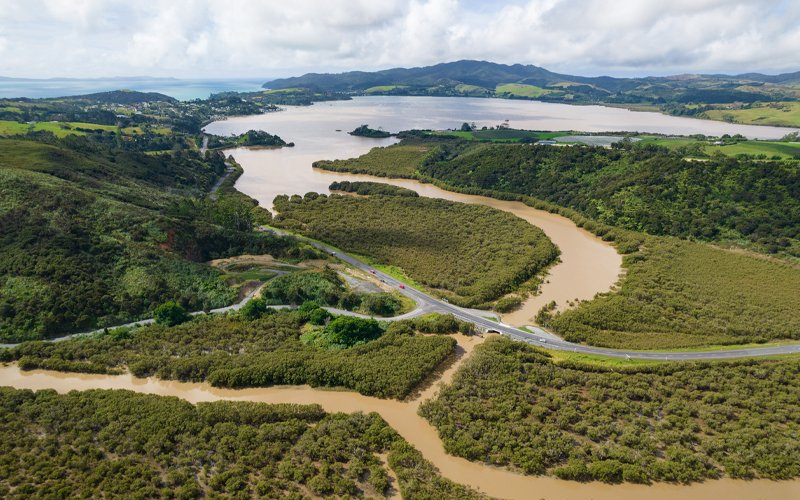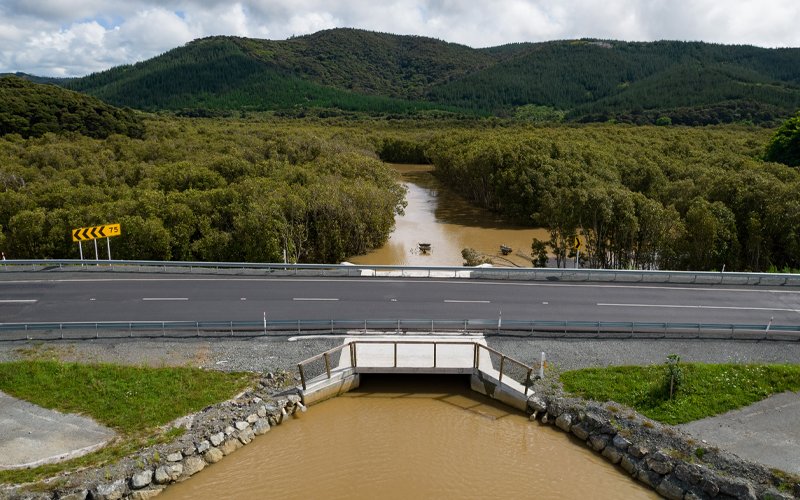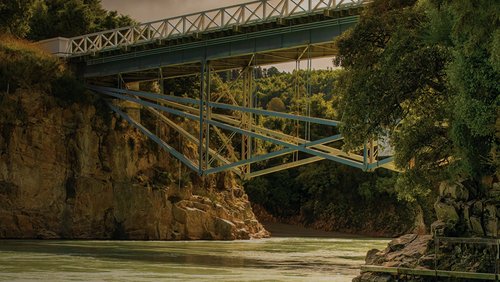6 Apr 2023
An innovative, collaborative project to replace a 1960s culvert has led to restored water flow, revitalised wetlands and flood reduction.
A causeway, built in the 1960s to replace a failing bridge on State Highway 10, had turned what was once a free-flowing river and food source for tangata whenua into a mangrove swamp. The tidal flow of Northland’s Mangōnui estuary was restricted, which reduced the quality of the marine environment, took land away from tangata whenua and blocked easy access to the water.
Three hapū were instrumental in bringing the deteriorating environmental condition of the waterway to the attention of Waka Kotahi. Discussions began between tangata whenua and Waka Kotahi to seek a solution to restore the natural marine waterway around State Highway 10 south of Mangōnui and to help the ecology to flourish once more.
At first, there were detailed designs to create a box culvert replacement solution. But discussions soon revealed the proposed culvert and channel clearing were not a practical solution and a bridge would be more effective.
“There was a cost-time challenge with this work,” explains Shaun Grieve CMEngNZ, Principal Geotechnical Engineer/Team Leader – Civil at WSP.
“There was a fixed budget, and construction needed to start by the end of August 2021 for the funding to be retained through the Provisional Growth Fund. We wanted this construction to occur with minimal disruption to the Far North community and maintain the level of service expected for a State Highway.”
The real breakthrough came, says Shaun, when the majority of the temporary works (to install the foundations for the originally planned culvert) became the solution for the permanent works.
“We had already dug a large hole and installed two retaining walls, below sea level. From there, through early contractor input (ECI), it was straightforward to construct a simple bridge, with a floating braced structure, using an existing supplier’s bridge deck to define the bridge length.”

The original culvert prior to construction of Tokatoka Bridge. Image: WSP
Shaun, along with WSP Civil Engineer Kathleen McMullen MEngNZ and the company’s design management team were able to then quickly do the design checks required to ensure a fast turnaround.
Within a couple of days you could see the mullet start to frolic, herring swimming upstream, and heron, shags and wading birds feeding.
The retaining abutments were changed from secant piles to sheet piles, meaning wins for cost, embodied carbon and reduced environmental risks.
“It took collaboration at every stage of this project to reach this innovative solution,” says Shaun.
“In a sense, the construction methodology was fairly standard, but it was the involvement of all parties – ourselves [WSP], Waka Kotahi, Fulton Hogan and the local community – at every stage of the project that makes this project so transformative.”
Sarah Whitehorn MEngNZ, Project Manager at Fulton Hogan, agrees, saying the success of the project was due to trusting relationships and open dialogue.
“This allowed ECI throughout the design, development and delivery stages. Everyone pulled together to improve constructability and an efficient programme for delivery.”

Aerial view looking north. Image: Aerial Vision
Collaboration at the fore
Another pivotal success factor was the partnerships with tangata whenua. The two local marae and the Pukenui
No. 2 Trust (owning the quarry adjacent to the site) provided kaitiaki or guardianship throughout the project.
“Waka Kotahi held a hui before any design works commenced to understand the cultural narrative and to determine the best solution with the allocated budget,” says Kathryn O’Reilly, Senior Project Manager (Complex) at Waka Kotahi.
“We all had trust that everybody was doing their best to achieve a positive outcome for the project.”
The collaboration extended to the borrowing of materials and access to those materials, with one hapu allowing materials to be taken from their quarry and dredging materials to be placed at the site. The Trust’s future vision for this land includes a native plant nursery and whare wānanga to teach youth about mahinga kai in the area.
“The construction team shaped the quarry for this future vision,” says Sarah.
She says the project was approached with care from start to finish, with tikanga including daily karakia.
“The day we ‘broke through’ creating the connection for the tide under the bridge, nature’s response was almost immediate,” says Sarah.
“Within a couple of days you could see the mullet start to frolic, herring swimming upstream, and heron, shags and wading birds feeding.”
Iwi are most proud that after nearly 50 years, the mauri of the awa has been restored, bringing life back to the communities surrounding the Tokatoka awa.
“The final product seems to be attracting fish and preying birds, which proves that it is achieving its purpose,” says Mike Erihe from Aputerewa Marae.
“Thanks to all the staff involved, we now have a structure that will be an absolute asset for those who now can fish there.”
“The fish have returned to the awa,” says Kathryn. “It is a beautiful sight to see this after over 40 years of nothing. The awa has come back to life. There is an energy present, and it is wonderful seeing that after such a long time.”

A local hapu allowed materials to be taken from their quarry and dredging materials to be placed at the site. Image: Aerial Vision
- Project: Reinstatement of a waterway that had existed prior to the construction of a causeway in the 1960s.
- People: WSP, Waka Kotahi NZ Transport Agency, Fulton Hogan, Far North Roading Group, Spirals Drillers Ltd, BUSCK Prestressed Concrete Ltd, Aputerewa Marae – Helen Larkin, Kenena Marae – Lydia Lloyd Pukenui No. 2 Block Trust – Peter Kitchen
- Location: State Highway 10, approximately 2km south of Mangōnui in the Far North
- Duration: May 2021 – April 2022
- Awards and accolades
- 2022 IPWEA Annual Excellence Awards, Best Public Works Project $2M - $5M.
- 2022 IPWEA Excellence in Environmental Sustainability
- Shortlisted for CCNZ awards and NRC Environmental Awards
This article was first published in the March 2023 issue of EG magazine.




